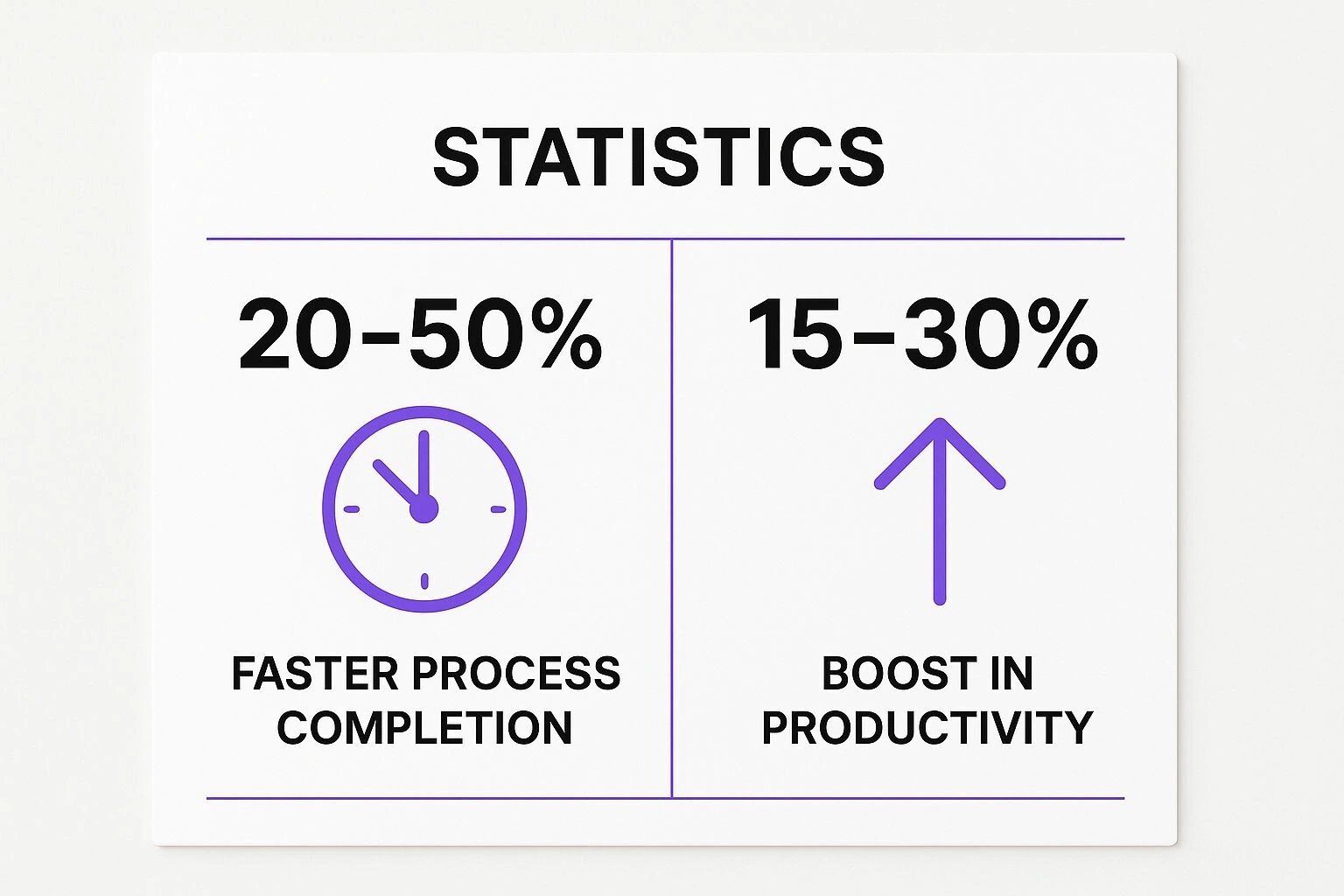Advantages of Business Process Automation | Boost Efficiency in 2025
Explore the advantages of business process automation and learn how it can boost efficiency, reduce costs, and enhance accuracy in 2025.

The challenge in streamlining operations lies in implementing changes that deliver tangible, lasting results. Business process automation (BPA) offers a powerful solution, moving beyond simple task management to fundamentally reshape how work gets done. It systematically redesigns workflows, integrating AI and sophisticated software to handle repetitive and complex processes with precision and speed. This strategic shift allows your team to redirect its focus towards high-value initiatives that drive genuine growth and innovation.
This article delves into the eight most impactful advantages of business process automation, providing a clear roadmap for transforming your operational framework. We will move beyond theory to offer practical insights and actionable steps for implementation. To truly understand the transformative power of automation and see it in action, explore a range of real-world business process automation examples that illustrate how these concepts are applied across various industries.
Each section will break down a core benefit, from significant cost reduction and enhanced data analytics to improved employee satisfaction and scalability. You will gain a clear understanding of how these advantages materialise and what they mean for your organisation’s competitive edge and long-term success.
1. Increased Operational Efficiency
One of the most compelling advantages of business process automation (BPA) is its direct and measurable impact on operational efficiency. At its core, automation re-engineers how work gets done by systematically eliminating manual, repetitive tasks that consume valuable employee time. This strategic removal of human intervention from high-volume, rule-based processes allows organisations to achieve more in less time, freeing up personnel to focus on high-value, strategic initiatives.
Automated systems operate continuously, 24/7, without performance degradation, sick days, or human error. This consistency establishes a new, higher standard for productivity and throughput. By identifying and resolving process bottlenecks, automation streamlines entire workflows, from data entry and validation to complex approval chains. For example, a manually processed invoice might take hours or even days to clear, whereas an automated system can handle validation, matching, and routing for approval in mere seconds. This unlocks significant gains in speed and capacity without requiring a proportional increase in headcount.
Key Metrics for Efficiency Gains
The tangible benefits of automation are clearly reflected in performance metrics. The following visualisation highlights the typical improvements organisations can expect.

These figures demonstrate that automation doesn’t just make minor adjustments; it fundamentally accelerates core business operations, creating a more agile and productive organisational structure.
Practical Implementation
To realise these efficiency gains, a structured approach is critical:
- Start Small: Begin by targeting high-volume, low-complexity tasks. These quick wins build momentum and demonstrate ROI.
- Process Mapping: Before implementing any tool, thoroughly map the existing workflow to identify inefficiencies and automation opportunities.
- Pilot Programs: Test automation solutions with a small-scale pilot project to refine the process and manage change effectively.
By eliminating manual tasks and streamlining workflows, businesses can achieve significant operational improvements. For a deeper dive into how this translates to sales, check out insights on sales process automation for boosted efficiency.
2. Significant Cost Reduction
Another of the core advantages of business process automation is its profound ability to drive significant cost reduction across an organisation. BPA achieves this by directly targeting labour-intensive, high-cost manual processes and minimising operational expenses. While automation platforms require an initial investment, the return on investment (ROI) is often realised swiftly, with many businesses reporting payback periods of 12-24 months through reduced staffing needs, fewer costly errors, and optimised resource allocation.
The economic benefits extend beyond simply cutting headcount. Automated systems reduce the need for overtime pay and the expenses associated with recruitment, onboarding, and training for repetitive roles. Furthermore, by eliminating errors that lead to rework, compliance penalties, or customer dissatisfaction, automation protects the bottom line from hidden costs. For instance, JPMorgan Chase famously deployed its COIN system to automate legal document review, saving an estimated 360,000 hours of manual work annually, which translates into millions in saved labour costs.
Key Metrics for Cost Savings
The financial impact of automation is tangible and can be tracked through several key performance indicators. The following visualisation illustrates the typical areas where organisations see the most substantial cost reductions.
These figures underscore how automation creates a leaner operational model, allowing businesses to reallocate capital from mundane operational upkeep to strategic growth and innovation initiatives.
Practical Implementation
To maximise cost savings from automation, a strategic and measured approach is essential:
- Calculate ROI: Before committing to a solution, perform a thorough ROI analysis to project savings and establish clear financial goals.
- Target High-Cost Processes: Prioritise the automation of processes that consume the most manual hours or are most prone to expensive errors for the quickest impact.
- Consider Cloud Solutions: Cloud-based automation platforms can lower the initial capital expenditure, making it easier for businesses to get started with a subscription-based model.
By systematically replacing expensive manual labour with efficient technology, organisations can achieve a more sustainable and profitable operational structure. For those interested in a specific technology, you can explore more on how this is achieved through Robotic Process Automation.
3. Enhanced Accuracy and Quality
Beyond speed, one of the most critical advantages of business process automation is the profound improvement in accuracy and output quality. Human error is an inherent variable in any manual process, particularly in tasks that are repetitive and data-intensive. Automation directly addresses this by executing processes based on predefined, unchangeable rules, thereby eliminating the inconsistencies, typos, and oversights that lead to costly mistakes.
By standardising workflows, automated systems ensure every task is performed the same way, every time. This consistency is fundamental to maintaining high quality standards and meeting compliance obligations. For instance, in manufacturing, Toyota’s quality control automation has famously achieved near-perfect, 99.9% defect-free production runs. Similarly, in highly regulated sectors like healthcare, Mayo Clinic’s automated prescription systems have reduced medication errors by an astounding 95%. This level of precision is virtually unattainable through manual effort alone and significantly reduces the financial and reputational costs associated with error correction.
Key Metrics for Quality Improvement
The impact of automation on accuracy is not theoretical; it is a measurable improvement that strengthens operational integrity. The following visualisation highlights the typical enhancements organisations can expect in quality and compliance.
These figures underscore how automation creates a more reliable and error-resistant operational framework, which directly translates to higher customer satisfaction and trust.
Practical Implementation
To leverage automation for superior accuracy, a meticulous approach is essential:
- Define Clear Rules: Document and embed precise business rules and data validation criteria into the automated workflow.
- Implement Checkpoints: For critical processes, build in multiple automated checkpoints to verify data and process integrity at each stage.
- Plan Exception Handling: Develop robust protocols for how the system should handle outliers or edge cases that fall outside standard rules.
- Regular Audits: Maintain comprehensive, automated audit trails to simplify quality assurance and compliance reporting.
By systematically removing the potential for human error, businesses can achieve a higher calibre of output. For those in logistics, a closer look at how Maersk reduced shipping documentation errors by 80% offers powerful insights into supply chain automation.
4. Improved Employee Satisfaction and Productivity
A significant, yet often underestimated, advantage of business process automation (BPA) is its profound effect on employee satisfaction and productivity. Automation strategically removes monotonous, rule-based tasks from daily workflows, freeing your human capital from the drudgery of data entry, report generation, and other repetitive activities. This shift allows employees to redirect their energy and expertise towards more engaging, creative, and high-value work that requires critical thinking and strategic insight.

When people are engaged in meaningful work, their sense of purpose and job satisfaction naturally increases. Organisations that champion this human-centric approach to automation, like Microsoft under Satya Nadella, often report higher employee morale and lower attrition rates. For instance, Accenture’s use of RPA enabled its consultants to focus more on high-level client strategy instead of manual data compilation, directly enhancing their professional impact and career development. This focus on empowering employees, rather than replacing them, is a core tenet of modern automation strategy.
Fostering a Motivated Workforce
Successfully integrating automation to boost employee satisfaction requires a thoughtful and transparent implementation plan. The goal is to present automation as a tool for empowerment.
- Involve Employees: Include team members in the process of identifying tasks for automation. They possess invaluable ground-level insights and their involvement fosters buy-in.
- Provide Comprehensive Training: Equip staff with the skills needed to work alongside new automated systems and take on elevated responsibilities.
- Communicate Career Pathways: Clearly outline how automation creates new opportunities for skill development and career progression within the organisation.
- Recognise Contributions: Celebrate the successes of newly automated workflows and acknowledge the employees who are now driving more strategic outcomes.
By liberating employees from mundane tasks, businesses not only boost productivity but also cultivate a more innovative, engaged, and loyal workforce. This transformation is a key driver of long-term organisational success.
5. Enhanced Scalability and Flexibility
One of the most transformative advantages of business process automation is its ability to confer immense scalability and flexibility. Traditional growth models tie operational capacity directly to human resources; scaling up means hiring, training, and managing more people. Automation severs this direct link, allowing a business to expand its output and handle fluctuating demand without the friction and cost associated with proportional workforce increases.
Automated systems are designed to handle variable workloads with consistent performance and quality. Whether processing ten transactions or ten thousand, the system executes each task with the same precision and speed. This agility enables organisations to respond rapidly to market shifts, seasonal peaks, or sudden growth opportunities. For instance, an e-commerce platform like Shopify can seamlessly onboard a surge of new merchants during a lockdown because its backend processes are automated, not constrained by manual capacity. Similarly, Uber’s dynamic pricing algorithms automatically adjust to real-time supply and demand, a feat impossible to manage at scale with human intervention. This inherent elasticity is a core component of modern business resilience.
Practical Implementation
To build automation that scales effectively, a strategic approach is essential:
- Design for Growth: Architect automation workflows with future expansion in mind. Avoid hardcoded limits and build modular components that can be easily updated or expanded.
- Leverage Cloud Solutions: Utilise cloud-based automation platforms that offer elastic infrastructure. This allows systems to automatically provision or de-provision resources based on real-time demand, ensuring optimal performance and cost-efficiency.
- Plan for Peak Loads: Proactively test and model how your automated systems will perform under extreme or peak load scenarios. This helps identify potential bottlenecks before they impact operations.
By embedding scalability into your automation strategy, you create a foundation for sustainable growth. Intelligent systems like AI agents are further amplifying this capability. You can explore how these technologies contribute by reading about the role of AI agents in business processes.
6. Better Data Management and Analytics
A significant, yet often understated, advantage of business process automation (BPA) is its profound ability to enhance data management and unlock sophisticated analytics. Automated systems serve as a source of truth by systematically capturing clean, structured, and real-time data at every stage of a workflow. This process eliminates the inconsistencies and errors inherent in manual data entry, providing a reliable foundation for strategic decision-making.

The data generated by automated processes is comprehensive and standardised, making it ideal for analysis. Organisations can track performance, identify trends, and uncover optimisation opportunities with unprecedented clarity. For example, Tesla’s manufacturing automation provides continuous metrics on production efficiency and quality control, while Amazon’s automated inventory management uses predictive analytics to optimise stock levels across its global network. This transformation turns operational data from a simple record into a strategic asset.
Key Metrics for Data-Driven Insights
The value of automated data collection is realised through its application in analytics. The following visualisation illustrates the typical improvements organisations can expect.
These figures show how automation directly improves the quality and accessibility of data, enabling more accurate forecasting and more insightful business intelligence.
Practical Implementation
To leverage automation for superior data analytics, a strategic approach is essential:
- Establish Data Quality Controls: Implement validation rules and automated checks from the outset to ensure data integrity.
- Standardise Reporting: Create uniform reporting formats and dashboards to make insights easily accessible and comparable across departments.
- Invest in Visualisation Tools: Use business intelligence (BI) tools to translate raw data into actionable visual insights for stakeholders.
- Train Teams on Interpretation: Equip employees with the skills to interpret data and use it to inform their decisions effectively.
By building a strong data foundation, businesses can move beyond reactive problem-solving to proactive, predictive strategy. Understanding the principles of data governance for better control is a critical first step in this journey.
7. Improved Customer Experience
One of the most powerful advantages of business process automation is its profound ability to elevate the customer experience. Automation transforms service delivery by ensuring faster responses, consistent quality, and 24/7 availability. By automating routine interactions and back-end processes, organisations can deliver a seamless, efficient, and personalised journey for their customers, significantly boosting satisfaction and fostering long-term loyalty.
Automated systems can handle customer queries, order processing, and status updates instantly, eliminating frustrating wait times. For example, Delta Airlines’ automated check-in and rebooking systems have drastically reduced call volumes by empowering customers with self-service options. Similarly, Sephora’s chatbot offers personalised beauty advice and product recommendations around the clock, meeting customer needs immediately. This frees up human agents to manage more complex, high-value interactions, ensuring that every customer receives the best possible support, whether from a human or an automated system.
Key Metrics for Customer Experience Gains
The impact of automation on customer satisfaction is clear and measurable. The following visualisation highlights the typical improvements organisations can expect when automating customer-facing processes.
These metrics underscore how automation not only streamlines internal operations but also creates a more responsive and satisfying experience for the end user, which is a critical differentiator in a competitive market.
Practical Implementation
To leverage automation for an enhanced customer experience, a strategic approach is essential:
- Map the Journey: Chart the entire customer journey to identify pain points and high-impact opportunities for automation, such as onboarding, support queries, or feedback collection.
- Maintain a Human Touch: Always provide a clear and easy escalation path for customers to connect with a human agent when needed.
- Personalise Interactions: Use customer data to tailor automated communications, making them more relevant and engaging rather than generic.
By strategically implementing automation, businesses can deliver a superior standard of service that builds trust and loyalty. To see how these principles apply in a financial context, learn more about leveraging automation in accounting.
8. Enhanced Compliance and Risk Management
A significant advantage of business process automation lies in its capacity to strengthen compliance and mitigate risk. By embedding regulatory standards and internal policies directly into automated workflows, organisations can ensure that processes are executed consistently and correctly every time. This systematic approach removes the variability and potential for oversight inherent in manual tasks, creating a robust framework for adherence.
Automated systems serve as a vigilant, always-on mechanism for compliance. They can monitor transactions and activities in real-time, flag potential deviations, and enforce rules without fail. For instance, HSBC automated key risk assessment processes and successfully reduced compliance processing time by 70%. Similarly, Johnson & Johnson leverages automated quality compliance systems to maintain strict adherence to FDA regulations. This built-in governance minimises exposure to penalties, reputational damage, and financial loss associated with non-compliance, transforming risk management from a reactive exercise into a proactive strategy.
Key Metrics for Compliance Gains
The impact of automation on risk and compliance is both qualitative and quantitative. Organisations can track tangible improvements in their governance frameworks.
These figures illustrate how automation provides a fortified defence against compliance failures and simplifies the traditionally complex audit process.
Practical Implementation
To embed compliance effectively within your automation strategy, a methodical approach is essential:
- Collaborate with Experts: Work closely with legal and compliance teams from the outset to ensure all rules and regulatory nuances are accurately translated into the automated process.
- Maintain Detailed Audit Logs: Configure systems to generate comprehensive, unalterable logs of every action taken. This provides an indisputable evidence trail for auditors.
- Build in Regular Reviews: Compliance is not static. Implement a schedule for reviewing and updating the automated rules to reflect changes in legislation and internal policies.
By embedding governance directly into operations, businesses can achieve a state of continuous compliance. For those focused on financial processes, learn more about automating accounts payable for better control.
Advantages Comparison of 8 Business Process Automation Factors
| Aspect | Increased Operational Efficiency | Significant Cost Reduction | Enhanced Accuracy and Quality | Improved Employee Satisfaction and Productivity | Enhanced Scalability and Flexibility | Better Data Management and Analytics | Improved Customer Experience | Enhanced Compliance and Risk Management |
|---|---|---|---|---|---|---|---|---|
| Implementation Complexity | Moderate to high; requires process redesign | High initial investment required | Moderate; needs clear business rules | Moderate; requires change management and retraining | Moderate to high; may need infrastructure upgrades | Moderate; requires robust data governance | Moderate; requires sophisticated AI for personalisation | High; complex regulatory rules implementation |
| Resource Requirements | Process optimisation, staff training, automation tools | Capital for technology and ongoing maintenance | Rule definition, validation systems, quality controls | Training, change management, employee involvement | Scalable infrastructure, cloud services | Data experts, analytics tools, secure data environment | AI systems, multi-channel platforms | Compliance experts, audit systems, continuous updates |
| Expected Outcomes | 20-50% faster processes; 15-30% productivity boost | 200-300% ROI in 2-3 years; reduced labor and overhead | 85-99% error reduction; 40-60% quality improvement | 20-40% higher satisfaction; 15-25% lower turnover | 5-10x volume handling; cost-effective scaling | 60-80% better data accuracy; 50-70% faster insights | 25-45% improved satisfaction; 30-50% faster responses | 60-90% fewer violations; 40-60% faster audits |
| Ideal Use Cases | High-volume repetitive processes needing speed and consistency | High-cost manual operations needing cost optimisation | Tasks requiring high precision and compliance | Employee task automation aimed at engagement and upskilling | Businesses with fluctuating demand or rapid growth needs | Data-driven decision environments needing real-time data | Customer service requiring speed and personalisation | Industries with strict regulatory compliance demands |
| Key Advantages | 24/7 operations; reduced manual bottlenecks; increased throughput | Fast ROI; sustainable savings; predictable costs | Near-zero errors; consistent quality; compliance adherence | Higher engagement; innovation; better work-life balance | Rapid scaling; elastic capacity; cost-effective growth | Accurate, real-time data; predictive analytics; audit trails | Immediate responses; omnichannel consistency; personalisation | Consistent compliance; reduced penalties; audit simplification |
Embarking on Your Automation Journey
The path from manual, siloed operations to a cohesive, automated ecosystem represents a fundamental shift in business strategy. As we have explored, the advantages of business process automation extend far beyond simple task completion. They form a strategic framework for building a more resilient, agile, and intelligent organisation. Moving past the theoretical benefits, the practical application of automation consistently delivers tangible results across the entire value chain.
We have seen how automation drives substantial cost reductions by optimising resource allocation and minimising manual effort. It fortifies accuracy, ensuring that critical data and processes are executed with a level of precision that human intervention alone cannot sustain. This commitment to quality directly enhances compliance frameworks and mitigates operational risk, providing a secure foundation for business activities. Simultaneously, by liberating your skilled teams from repetitive, administrative burdens, automation fosters a more engaged and innovative workforce, allowing talent to focus on strategic, high-value initiatives.
From Insight to Implementation: Your Next Steps
The evidence is clear: mastering business process automation is no longer a competitive edge but a foundational requirement for sustainable growth. The true value is not realised by simply adopting new technology, but by strategically integrating it into the core of your operations. The journey begins not with a sweeping overhaul, but with a targeted, analytical approach.
To translate these insights into action, consider these critical next steps:
- Conduct a Process Audit: Begin by identifying and mapping your current workflows. Pinpoint the bottlenecks, repetitive tasks, and error-prone processes that offer the highest potential for immediate automation impact. Prioritise based on a combination of feasibility and business value.
- Define Clear Objectives: What does success look like for your organisation? Is it reducing invoice processing time by 50%? Improving customer onboarding satisfaction scores? Set specific, measurable, achievable, relevant, and time-bound (SMART) goals for your automation initiatives.
- Develop a Phased Rollout Plan: Avoid the “big bang” approach. Implement automation in manageable phases, starting with a pilot project to prove the concept, gather feedback, and demonstrate return on investment. This iterative strategy minimises disruption and builds internal momentum.
Embracing these steps transforms the conceptual advantages of business process automation into a concrete roadmap for organisational evolution. It’s about building a system where enhanced efficiency, data-driven decisions, and superior customer experiences are not just goals, but the standard operational reality. This proactive stance equips your enterprise to not only navigate current market complexities but to proactively shape its future.
Ready to translate the advantages of business process automation into a competitive reality for your organisation? The expert team at Osher Digital specialises in a vendor-agnostic approach, designing and implementing tailored automation solutions that align perfectly with your strategic goals. Contact Osher Digital today to schedule a discovery call and begin your transformation journey.
Jump to a section
Ready to streamline your operations?
Get in touch for a free consultation to see how we can streamline your operations and increase your productivity.